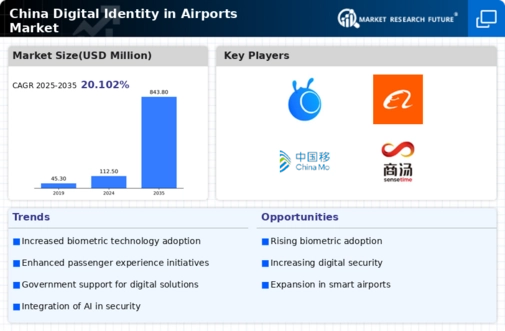Rising Security Concerns
Rising security concerns are propelling the digital identity-in-airports market in China. With the increasing frequency of security threats, airports are under pressure to enhance their security measures. Digital identity solutions, particularly those utilizing biometric technologies, offer a robust response to these challenges. By ensuring that only authorized individuals gain access to secure areas, these systems help mitigate risks associated with unauthorized access. The market is likely to see a surge in demand for advanced security solutions as airports prioritize passenger safety. Consequently, the digital identity-in-airports market is positioned to grow as stakeholders seek to implement comprehensive security frameworks.
Increasing Passenger Volume
The digital identity-in-airports market in China is experiencing growth driven by the increasing volume of air travelers. In recent years, the number of passengers traveling through Chinese airports has surged, with estimates indicating a rise to over 1.5 billion passengers annually by 2025. This influx necessitates efficient processing systems to manage the flow of travelers. Digital identity solutions, such as biometric verification, are being implemented to streamline check-in, security, and boarding processes. By reducing wait times and enhancing the overall passenger experience, these technologies are becoming essential in accommodating the growing demand. The digital identity-in-airports market is thus positioned to benefit from this trend, as airports seek to modernize their operations to handle the increasing passenger load.
Government Initiatives and Investments
The Chinese government is actively promoting the digital identity-in-airports market through various initiatives and investments. Recognizing the importance of modernizing airport infrastructure, the government has allocated substantial funding to enhance digital capabilities. For instance, the 14th Five-Year Plan emphasizes the integration of advanced technologies in transportation, including airports. This strategic focus is likely to lead to the implementation of digital identity solutions that improve security and efficiency. Furthermore, partnerships between government agencies and technology providers are fostering innovation in the digital identity space. As a result, the digital identity-in-airports market is expected to expand, driven by supportive policies and financial backing from the government.
Enhanced Passenger Experience Expectations
The digital identity-in-airports market is also being driven by heightened expectations for passenger experience in China. Modern travelers increasingly demand seamless and efficient airport processes, which digital identity solutions can provide. Technologies such as mobile check-in and automated boarding gates are becoming standard as passengers seek convenience. The integration of digital identity systems can significantly enhance the travel experience by minimizing delays and simplifying procedures. As airports strive to meet these evolving expectations, the digital identity-in-airports market is likely to expand, with a focus on solutions that prioritize user-friendly interfaces and streamlined operations.
Technological Advancements in Biometric Systems
Technological advancements in biometric systems are significantly influencing the digital identity-in-airports market in China. Innovations in facial recognition, fingerprint scanning, and iris recognition are enhancing the accuracy and speed of identity verification processes. These advancements are crucial for airports aiming to improve security while expediting passenger flow. For example, the implementation of AI-driven biometric systems can reduce processing times by up to 50%, thereby enhancing operational efficiency. As airports increasingly adopt these cutting-edge technologies, the digital identity-in-airports market is likely to witness substantial growth, driven by the demand for more reliable and efficient identity verification methods.















Leave a Comment